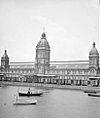Thomas_Scott_(architect)
Thomas Seaton Scott
Canadian architect
Thomas Seaton Scott (16 August 1826 – 15 or 16 June 1895) was an English-born Canadian architect. Born in Birkenhead, England he immigrated to Canada as a young man first settling in Montreal. He was hired by the Grand Trunk Railway and worked for them on a number of structures including the Union Station in Toronto and Bonaventure Station in Montreal.
In 1871 he was hired by the Department of Public Works and he designed a number of Ottawa's new government buildings in the years after Canadian Confederation. Among his works are the West Block of the Parliament of Canada, the Cartier Square Drill Hall, and the now demolished Dominion Post Office. From 1872 to 1881 he held the position of Chief Dominion Architect and thus played at least a supervisory role in all major government projects. He is considered one of the creators of the Dominion Style that dominated Canadian institutional architecture in the nineteenth century. He was a founding member of the Royal Canadian Academy of Arts[1] He was succeeded as Chief Architect by Thomas Fuller.





